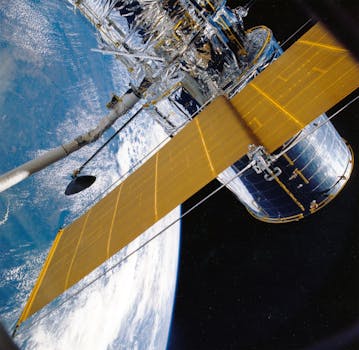Future of Satellites: Revolutionizing Global Connectivity and Exploration
The future of satellites holds immense potential for revolutionizing global connectivity, exploration, and various industries. With advancements in space technology, satellites are becoming increasingly vital for our daily lives.

Future of satellites is a rapidly evolving field that is transforming the way we communicate, navigate, and explore space. The future of satellites holds immense potential for revolutionizing global connectivity, exploration, and various industries. With advancements in space technology, satellites are becoming increasingly vital for our daily lives. From providing internet access to remote areas to enabling precise navigation and weather forecasting, satellites play a crucial role in our modern world.
The use of satellites has become widespread across various sectors, including telecommunications, navigation, meteorology, and remote sensing. Satellites are used for a range of applications, from broadcasting television channels and providing mobile networks to monitoring climate change and tracking natural disasters. The demand for satellite services is on the rise, driven by the growing need for global connectivity, accurate navigation, and real-time data.
One of the most significant developments in the field of satellites is the emergence of satellite internet. Companies like SpaceX, Amazon, and OneWeb are launching constellations of low-Earth orbit satellites to provide high-speed internet access to remote and underserved communities. This technology has the potential to bridge the digital divide and bring billions of people online, enabling them to access information, education, and economic opportunities.
Advancements in Satellite Technology
Recent advancements in satellite technology have led to the development of smaller, cheaper, and more efficient satellites. The use of advanced materials, such as lightweight composites and 3D printing, has enabled the creation of smaller satellites that can be launched at a lower cost. This has democratized access to space, allowing more companies and countries to launch their own satellites and participate in the global space economy.
The development of reusable rockets has also significantly reduced the cost of launching satellites into space. Companies like SpaceX and Blue Origin have pioneered reusable rocket technology, which has made it possible to launch satellites at a fraction of the cost of traditional launch methods. This has opened up new opportunities for satellite operators and has enabled the launch of more frequent and complex satellite missions.
In addition to these advancements, there have been significant improvements in satellite propulsion systems, power generation, and communication technologies. The use of advanced propulsion systems, such as electric propulsion and Hall effect thrusters, has enabled satellites to operate more efficiently and extend their lifespan. The development of high-efficiency solar panels and advanced battery technologies has also improved the power generation capabilities of satellites, enabling them to support more powerful payloads and operate for longer periods.
Applications of Satellites
Satellites have a wide range of applications across various industries, including telecommunications, navigation, meteorology, and remote sensing. In the telecommunications sector, satellites are used to provide mobile networks, broadcast television channels, and enable broadband internet access. The use of satellites for navigation has become increasingly important, with systems like GPS and Galileo providing precise location and timing information for a range of applications, from aviation and maritime to agriculture and surveying.
Satellites are also used extensively in meteorology, providing critical data for weather forecasting and climate monitoring. Geostationary satellites, such as those operated by the National Oceanic and Atmospheric Administration (NOAA), provide continuous imagery of the Earth’s weather patterns, enabling meteorologists to track storms and predict weather events. Polar-orbiting satellites, such as those operated by the European Space Agency (ESA), provide high-resolution imagery of the Earth’s surface, enabling scientists to study climate change and monitor natural disasters.
In the field of remote sensing, satellites are used to gather data about the Earth’s surface and atmosphere. Satellites like Landsat and Sentinel-2 provide high-resolution imagery of the Earth’s surface, enabling scientists to study land use, deforestation, and environmental changes. Satellites like SMOS and SMAP provide data on soil moisture and ocean salinity, enabling scientists to study the Earth’s water cycle and monitor droughts and floods.
Challenges and Opportunities
Despite the many advancements and applications of satellites, there are several challenges and opportunities that need to be addressed. One of the major challenges facing the satellite industry is the growing problem of space debris. The increasing number of satellites in orbit has led to a significant rise in space debris, which poses a significant risk to operational satellites and other space-based assets. The development of sustainable space practices and the implementation of debris removal technologies are essential to mitigate this risk and ensure the long-term sustainability of space activities.
Another challenge facing the satellite industry is the need for improved regulation and governance. The lack of clear regulations and international cooperation has led to a range of issues, from frequency interference and spectrum management to satellite collisions and debris removal. The development of robust regulatory frameworks and international cooperation is essential to ensure the safe and responsible use of space and to prevent conflicts and accidents.
Despite these challenges, the future of satellites holds immense opportunities for innovation and growth. The development of new technologies, such as quantum communications and artificial intelligence, is expected to transform the satellite industry and enable new applications and services. The growing demand for satellite services, driven by the increasing need for global connectivity and accurate navigation, is expected to drive growth and investment in the satellite industry, creating new opportunities for companies and countries to participate in the global space economy.
Conclusion
In conclusion, the future of satellites is a rapidly evolving field that holds immense potential for revolutionizing global connectivity, exploration, and various industries. With advancements in space technology, satellites are becoming increasingly vital for our daily lives, providing internet access, precise navigation, and critical data for weather forecasting and climate monitoring. The development of sustainable space practices, improved regulation, and international cooperation is essential to ensure the long-term sustainability of space activities and to prevent conflicts and accidents. As the satellite industry continues to grow and evolve, it is expected to create new opportunities for innovation, investment, and growth, transforming the way we communicate, navigate, and explore space.







